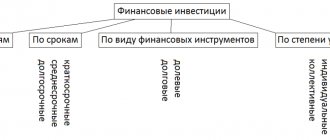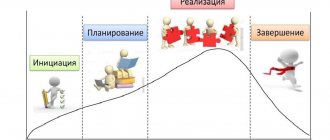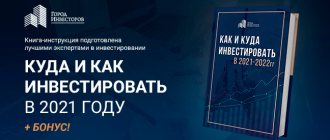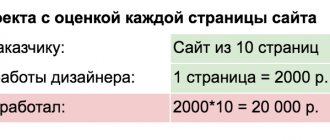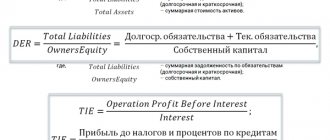59565
0
Author of the article:
Sultanov Iskander Anvarovich
Founder of Projectimo.ru
Recent publications by the author:
Systematic labor standardization project
Implementation of a project to transfer accounting to outsourcing
Anticipation of significant changes in investments
The article will focus on a manufacturing business that was not created yesterday. The question of efficient investment of capital does not arise immediately. To do this, activities must be stabilized and capital must be generated from profits. The rate of profit growth is obvious to the owners, and they are ready not to withdraw funds, but to invest them in development. There are still many conditions for productive investment activities of the company. We are now interested in the phases of an investment-type project in connection with the logic of the complex investment process that occurs cyclically in business.
Life cycle of an investment project - what is it?
The life cycle of an investment project is the time interval from the idea of the project to its complete liquidation. This is the basic concept for analyzing financing, which allows you to make smart decisions related to the organization, development and completion of the project.
An investment project goes through four successive phases: pre-investment, investment, operational and liquidation. Let's look at each stage in detail.
Operational and liquidation-analytical stages
After the investment phase, the project is not yet completed. The project enters a new phase called the “operational phase.” At this stage, economic activity is carried out on a newly created object or complex of fixed capital objects. During the initiated operating cycle, which arose as a result of the implementation of the investment project, cash flows are generated: receipts and disposals. Like any production cycle, the operational phase has its own problems:
- difficulties with the rhythm of production;
- difficulties in organizing and maintaining sales at a high level;
- lack of working capital and financing of current expenses.
As a rule, the duration of this phase is planned at the design stage. For each equipment, the manufacturer sets a standard service life. The operational phase should last just long enough to comply with the current investment policy. It usually defines issues of depreciation, wear and tear of equipment, including moral wear, and procedures for economically justified renewal of the company’s fixed assets.
Management of an investment project at the operational stage is based on economic efficiency indicators. They depend on the duration of the life cycle stage and the level of return of the property complex. In this regard, during this phase, there may be a need for additional non-critical investments in order to increase the return on fixed capital.
Completion of the project is accompanied by the implementation of the liquidation and analytical stage. At this phase, at least three tasks are solved.
- Elimination of emerging or potential negative consequences from the results of the project. Such issues are regulated by law. For example, environmental impact and environmental disruption. The work is quite capital-intensive, but really necessary. Completion of the project must take into account such expenses, which were included during the design.
- At the very beginning of the article, we clarified that the projects are part of a single investment program, which includes a number of parallel and sequential projects. At the liquidation stage, production facilities are repurposed and working capital is released. Managing this process is not an easy task and requires serious organization and regulatory support.
- Completion of a project necessarily involves summing up its results, assessing and analyzing the achievement of the goals and objectives set for the project. We are working on bugs and expanding the library of investment and technological solutions. Analysis of project results provides invaluable experience for the development of financial and economic justification, methods for attracting investment funds, and the growth of the culture of project and investment activities.
Investment projects are a special category of development of a manufacturing company. The stages of the project at each phase of its life cycle have unique specificity due to the presence of a separate group of participants. These participants are investors and lenders. The company bears a high responsibility to them in terms of financial returns. Their presence leaves an imprint on the pre-investment phase of the project, and on all others too. The complexity of the project increases. However, I see only the positive side of this, because control and patronage improve the quality of decisions and implementation. And, ultimately, the success of project activities increases.
The first phase of the investment project is pre-investment
The pre-investment phase is the most important period of the project. This is the time from the emergence of an idea to the decision to implement it. Project initiators choose one or more investment options. To do this, you need to compare the effectiveness and riskiness of each and evaluate the available resources.
At this stage, the viability of the idea is assessed in financial, organizational, technical and economic terms. Usually this phase takes place without the participation of investors.
The initiators of the project form the initial concept of the project, analyze and justify the idea, and work out the technical side of its implementation.
Besides:
- determine the location of the object in which they propose to invest, work out steps to coordinate the project with the local administration;
- develop technical documents for the development of investments;
- analyze their own and investment financial capabilities, consider sources of attracting investments;
- describe the resources needed to implement the project;
- develop a business plan that shows the attractiveness of the initiative for the investor;
- draw up an investment declaration (memorandum) - an offer to the investor to invest in the enterprise;
- looking for an investor;
- determine an organization that will draw up design estimates and allocate money for this;
- carry out an examination of prepared documents;
- adjust the feasibility study (feasibility study), which presents the feasibility of creating a product;
- obtain permits for the construction of the facility, develop and approve a construction schedule;
- hand over the documentation to the investor and coordinate the stages of work with him.
Investment policy and investment program
The investment process is regularly replicated with each strategic iteration. At the moments of formulation and correction of the development strategy, the directions of the enterprise’s activities for the future are established. Priorities are also set for the use of earned funds. This is greatly facilitated by management based on existing policies: financial, dividend, investment. When developing a strategy, a number of issues are addressed:
- according to market, marketing, financial and technological forecasts;
- developing long-term goals and directions for the company’s development;
- composition of problem areas of activity and management;
- development of systemic measures, including those of an investment nature;
- potential areas of investment in fixed assets;
- to clarify the investment policy.
Investment policy is, on the one hand, a set of rules and principles in accordance with which management is based on the company’s investment cycle. On the other hand, this policy is a set of concepts and decisions that establish the structure, volumes and standard directions of investments in fixed assets and other long-term assets. Even in a medium-sized company, a lot of long-term capital investment initiatives are formed every year. Not all initiatives turn into projects, but a select few are included in investment programs.
Visual diagram of the investment program
A program is understood as a group of interrelated projects and other types of activities that are united by a common goal and conditions for their implementation. In addition to the implementation of projects, the program usually also includes subsequent operational activities. Forecast market estimates, financial disposition, technical and technological trends, understood at a strategic level, form the basis of programs.
Typically, based on the established programs, the finance department is annually tasked with developing a capital investment budget for the coming period. Based on a multi-stage process of analysis and clarification of the financial resource base, the composition of projects is ranked. As a result, a pool of projects acceptable for implementation appears that are included in the portfolio. The developed portfolio is presented to senior management for approval. This is the typical logic of the development of events in the investment process until the start of the implementation stage.
Investment phase
At the investment phase of the cycle, an investor is often involved in the project, who provides the start of the project with his own financing.
This is the time when the project initiators develop project documentation, enter into contract agreements (choose a construction organization, calculate construction estimates). Then:
- prepare the construction site and begin to build the facility;
- purchase technologies and equipment; deliver, install and prepare equipment for launch;
- recruit personnel and train them to work on site;
- form the capital of the enterprise - fixed and working capital;
- They produce prototypes of the product and gradually bring the enterprise to its designed capacity.
In this phase, the level of costs increases sharply. This phase ends with the commissioning of the facility.
At the same time, marketing activities are carried out to bring the product to the market and build a brand.
Liquidation stage
The onset of the liquidation stage can be due to several different reasons. Firstly, it can start after all possibilities for further development of the investment project have been exhausted. Secondly, it can be triggered by a profitable commercial offer received by the asset owner from a third-party investor. Thirdly, investment can be curtailed in the situation described above, in which the existing project does not live up to expectations.
The liquidation stage for an investor is always additionally associated with the analysis of information obtained during the implementation of the project. The result of this should be specific conclusions about the mistakes and inaccuracies made that did not allow the maximum profit to be extracted from the asset. Such analytical work is carried out so that in the future the investor will more successfully implement future investment projects.
]]> Stages of development of an investment project
The article will focus on a manufacturing business that was not created yesterday. The question of efficient investment of capital does not arise immediately. To do this, activities must be stabilized and capital must be generated from profits. The rate of profit growth is obvious to the owners, and they are ready not to withdraw funds, but to invest them in development. There are still many conditions for productive investment activities of the company. We are now interested in the phases of an investment-type project in connection with the logic of the complex investment process that occurs cyclically in business.
Operational phase
Most of the investment life cycle is the operational phase. It accounts for 90-95 percent of all time.
The longer this stage is, the more effective the project is. At that time:
- organize production;
- receive product certificates;
- promote it on the market;
- organize service (if necessary, repairs and warranty service of products);
- manage production taking into account market changes;
- monitor production efficiency;
- determine the moment when consumer interest in the product decreases and find ways to maintain it.
Costs at this stage remain stable.

